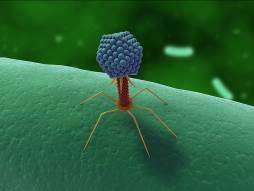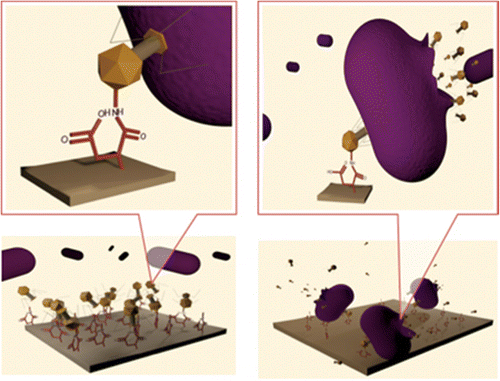Using 'bacteria-eaters' to prevent infections on medical implant materials

They're ba-ack! But in a new disease-fighting role. Viruses that infect and kill bacteria—used to treat infections in the pre-antibiotic era a century ago and in the former Soviet Union today—may have a new role in preventing formation of the sticky "biofilms" of bacteria responsible for infections on implanted medical devices. That's the topic of a report in the ACS journal Biomacromolecules.
Marek Urban and colleagues explain that bacteriophages (literally, "bacteria eaters") were first used to treat bacterial infections in the 19th century. These viruses—more than 1,000 different kinds exist—attack disease-causing bacteria. The scientists focused on use of phages to wage "microbial warfare" on the films of bacteria that form on catheters, stents and other medical implants. These infections, which often involve antibiotic-resistant bacteria, strike more than a million patients annually in the United States alone, increasing hospital bills by almost $1 billion.

They describe attachment of phages to the surfaces of materials like those used in implanted medical devices, and evidence that the phages remain active, killing E. coli and Staphylococcus aureus. Those bacteria cause the most common hospital-acquired infections. The technology can attach phages to almost any surface, and is "a promising and effective means of not only combating antibiotic-resistant infections, but also the technological platform for the development of bacteria sensing and detecting devices."
More information: Phage-Bacterium War on Polymeric Surfaces: Can Surface-Anchored Bacteriophages Eliminate Microbial Infections? Biomacromolecules, Article ASAP. DOI: 10.1021/bm400290u
Abstract
These studies illustrate synthetic paths to covalently attach T1 and Φ11 bacteriophages (phages) to inert polymeric surfaces while maintaining the bacteriophage's biological activities capable of killing deadly human pathogens. The first step involved the formation of acid (COOH) groups on polyethylene (PE) and polytetrafluoroethylene (PTFE) surfaces using microwave plasma reactions in the presence of maleic anhydride, followed by covalent attachment of T1 and Φ11 species via primary amine groups. The phages effectively retain their biological activity manifested by a rapid infection with their own DNA and effective destruction of Escherichia coli and Staphylococcus aureus human pathogens. These studies show that simultaneous covalent attachment of two biologically active phages effectively destroy both bacterial colonies and eliminate biofilm formation, thus offering an opportunity for an effective combat against multibacterial colonies as well as surface detections of other pathogens.
Journal information: Biomacromolecules
Provided by American Chemical Society

















